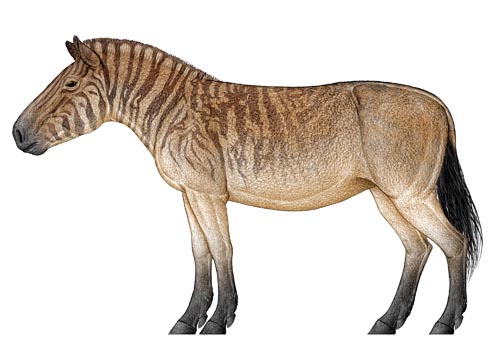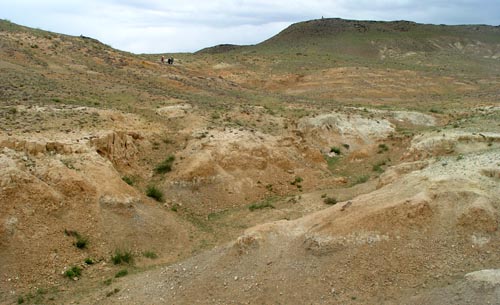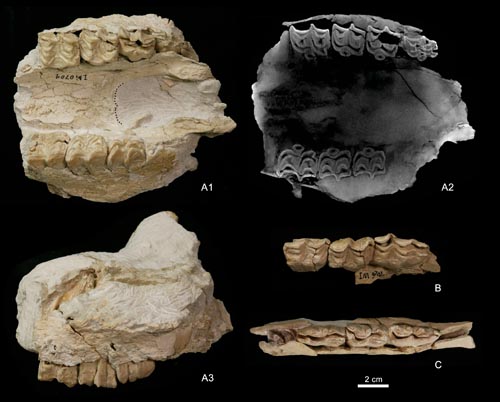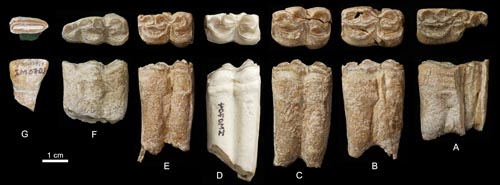| Location: Home > Resources > Multimedia |
| Hipparion tchikoicum from Baogeda Ula |
|
Fig. 1 Reconstruction of Hipparion tchikoicum (illustrated by Chen Yu) Fig. 2 Photograph of Baogeda Ula section with the capping basalt as a dark rim on the top
Fig. 3 Juvenile maxillary and deciduous teeth of Hipparion tchikoicum from Baogeda Ula
Fig. 4 Lower teeth of Hipparion tchikoicum from Baogeda Ula
Hipparionine horses were extensively distributed in North America and the Old World, and they were especially abundant during the Late Miocene and Pliocene in Eurasia. As a result, Hipparion fossils are important biological markers for stratigraphic correlations as well as climatic and environmental reconstructions. The fossils of the genus Hipparion are the most representative in the Late Miocene and Pliocene terrestrial strata of China, and their rich specimens are found in many fossil localities. Like most localities bearing Hipparion in China, the Hipparion fossils in central Inner Mongolia were collected from the red clay deposits, such as Tuchengzi in Huade County and Wulanhua in Siziwang Banner. From the fluvial and lacustrine deposits of central Inner Mongolia, a great number of micromammalian localities have been discovered, in which sporadic Hipparion fossils were mentioned, without specific reports and detailed descriptions. Deng and his colleagues reported Hipparion (Baryhipparion) tchikoicum from the Late Miocene deposits at Baogeda Ula in Abag Banner, Inner Mongolia, China in the latest issue of Historical Biology online, an international journal of paleobiology. The deep ectoflexids of the premolars and the rounded double-knots of the lower cheek teeth place the Baogeda Ula specimens in the primitive forms of Hipparion in Eurasia. The two North American species of Hipparion, H. shirleyi and H. tehonense with deep ectoflexids and rounded double-knots in the lower premolars, may be the ancestral forms of the subgenus Baryhipparion. The new discovery made the Eurasian expansion of this subgenus clear: it first appeared in North China during the latest Miocene, and then spread northward to the Mongolian Plateau and Transbaikalia; it migrated westward into Europe through Kazakhstan and Caucasus in the Pliocene; and it survived in Transbaikalia until the Early Pleistocene. The Baogeda Ula site is located 6 km from Baogeda Ula Sumu (Sumu means Township in Mongolian) in Abag Banner, Inner Mongolia. The exposed strata are a series of variegated fluvial and lacustrine mudstones, with a visible thickness of more than 100 m, covered by a thick layer of basalts on the top. Baogeda Ula has the only Hipparion record in eastern Asia that is associated with a layer of basalt. In the field work of 2007, the IVPP team found a maxillary and some isolated teeth of Hipparion from Baogeda Ula. In 2009, an excavation found more Hipparion fossils, including upper and lower jaws of juvenile individuals, isolated teeth, and bone fragments from this site. The main features of these specimens include large size, short and rounded protocones, deep ectoflexids in lower premolars, and rounded double-knots. These characters are consistent with the diagnosis of Hipparion (Baryhipparion) tchikoicum. Hipparion tchikoicum belongs to the subgenus Baryhipparion, a primitive group of hipparionine horses that occurs mostly in the Pliocene of northern Eurasia. The discovery of more localities bearing H. tchikoicum is beneficial for us to understand the zoogeographical significance of the subgenus Baryhipparion. Furthermore, the Baogeda Ula Hipparion connects the distribution of this species in the Yushe Basin and Mongolia. H. tchikoicum was earlier than H. insperatum chronologically, and the distribution of the former started from the latest Baodean because the specimens of H. tchikoicum were collected from the variegated clays at the top of the Mahui Formation at Ouniwa. At the type locality of H. insperatum, the exposed strata are the top of the Gaozhuang and Mazegou formations. The geological age of the late Cenozoic strata has been well dated, with concluded that the boundary between the Mahui and Gaozhuang formations being at 5.7 Ma, so the first appearance of H. tchikoicum should be around 6 Ma. This age is a good reference for the Baogeda Ula Hipparion. Combining the dating of the basalts and the micromammalian fossils below the horizon of the Hipparion layer, the age of the Hipparion bed at Baogeda Ula should be 6 Ma. |



